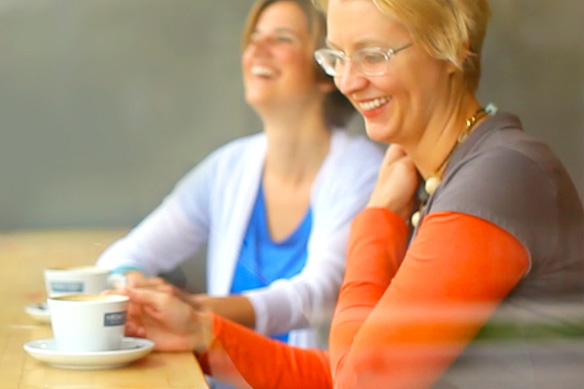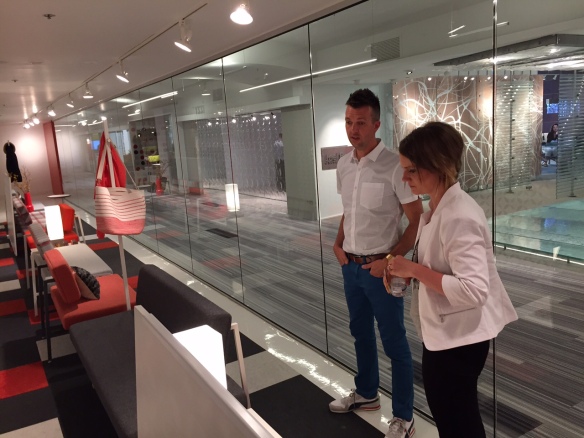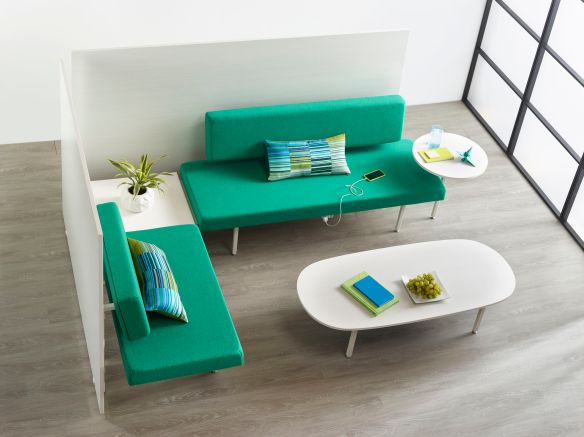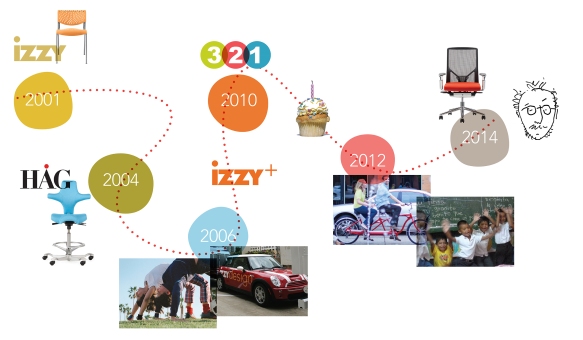
Allison Roon and Kerry Rowe, above, created izzy+ flavors, the new color and materials program being introduced this month at NeoCon. Recently, izzy+’s writer, Kristin Tennant, sat down with Allison (wearing white and blue in the photo above) to talk about this foundational element of the izzy+ brand—why it’s important, what inspired the palette, and how, in turn, these tools will inspire designs and spaces.
——————————–
What sparked the creation of a new color and materials program?
We started developing the program more than two years ago, because we wanted to bring the izzy+ Better Together story to life through surface materials. We also wanted a color and materials program that reflects izzy+’s brand and design philosophy. It’s a very design-driven company, in a foundational way. For izzy+, that focus has never been just about product design, it also about color and materials.
What were your sources of inspiration?
Fashion was huge for us, not just in terms of trend-forward color, but also in how different elements can be put together. We love the layering aspect of fashion, and all the opportunities it brings to mix different colors and materials in unexpected, fresh ways. Fashion gives us a model for mixing timeless classic—those practical, core parts of your wardrobe—with splashes of more trendy color and accessories. The goal is to provide that perfect balance between timeless and trendy. This approach applies to a very izzy+ way of designing spaces, too.
What do you mean by that “very izzy+” approach?
Well, one of the biggest sources of inspiration for flavors was the feel and personality of the izzy+ brand itself. From its start at NeoCon in 2001, with it’s Mini Cooper parked outside the Merchandise Mart with the convoy of big tractor trailors, the izzy+ brand has been a little quirky and off-center. It possesses a strong human element that doesn’t take itself too seriously—a youthful spirit that’s easy to be around.
How would you characterize the palette you ended up with?
In terms of color, Kerry really felt izzy+ was in a position to move the [contract furniture] industry forward. We started with 15 core plastic seating colors—eight Evolving, trend-forward colors with lots of bold energy, and seven Classic colors—and then we built the rest of the program out from there.
Being a young company means we have the opportunity to start fresh and to conceptualize around color and materials. We don’t have to worry about a legacy, so we can take risks. That’s why you won’t find traditional colors like navy, hunter green or burgundy in our palette. It’s time to move on, and we think izzy+ is the company to make that move. Chuck (Saylor) and everyone at izzy+ really feels passionate and excited about bringing a relevant palette to the market. People appreciate the honesty and authenticity, as well as the quirky personality.
What does it mean for colors and materials to be “authentic”?
Authentic materials are materials that are very approachable both in how they feel and how they look. They’re enticing and demand to be touched—they invite human-to-product engagement. They’re also not stuffy or too high-end, just simple, natural and clean.
So is the colors and materials program bigger than it used to be?
Well, it’s definitely broader and more fresh, but all of the redundancies and dull, old colors were eliminated, so it’s more efficient. As Kerry and I were doing our research, we listened to several focus groups and learned that the A&D community really looks to izzy+ to provide lots of options and personality, unique, fresh colors, and something different. Many other companies in the industry are paring down their materials program right now, but designers were begging us not to do that. We decided to broaden our program, but do it responsibly, in a trend-forward way that gives the A&D market more options for expression.
Specifiers have also been telling us they need all the izzy+ brands and products to work together, and to also coordinate with other competitive environments. That was part of our thought process, as we eliminated redundancies, filled in voids, and made the whole program consistent and easier to use across the different brands.
Do you have an example?
Our laminates are a great example. We went from a total of 75 laminates being offered across the various izzy+ brands to 35, 27 of which are new. We overhauled all of the finishes—there isn’t a single area we didn’t take this thorough approach with.
Designers will definitely be happy about that!
It’s definitely going to be easier to use. Everything is consistent and works together, across the different palettes and brands. But flavors isn’t just designed to be easier to use. We also created it as a tool for designers—one that really inspires them in new ways, providing plenty of options and ideas for creating more inspiring spaces. We did all the work when we curated the program, so designers can come to us for a fantastic collection of ingredients.
When you look back at the past two years, what were your favorite aspects of the process?
I really loved the way Kerry and I came together and created the perfect team. Kerry’s background is in textile design and color, and my background is in applying color and materials to spaces. Our collaboration is a perfect example of izzy+’s Better Together mantra.
We also met with lots of materials industry people along the way, especially at the Color Marketing Group conference in Portland. There was lots of sharing and input, in both directions. Some really important collaborations and partnerships formed, and we were able to align ourselves with great companies that put the same level of importance on design, like Formica, Maharam, Camira, Greenhides, Momentum, Knoll Textiles, and 3Form.
What’s next?
This is just the beginning of the journey. We’ve included some Core and Classic offerings that will be there as a foundational platform, but the Evolving colors and materials will keep changing. We’ll always be introducing new things that keep designers excited and engaged with our product. The whole flavors brand was designed to be an innovative, evolving platform that sets the stage for the future.

Ta-da! The 15 foundational colors of izzy+ flavors. The entire flavors program was built around this core.
















